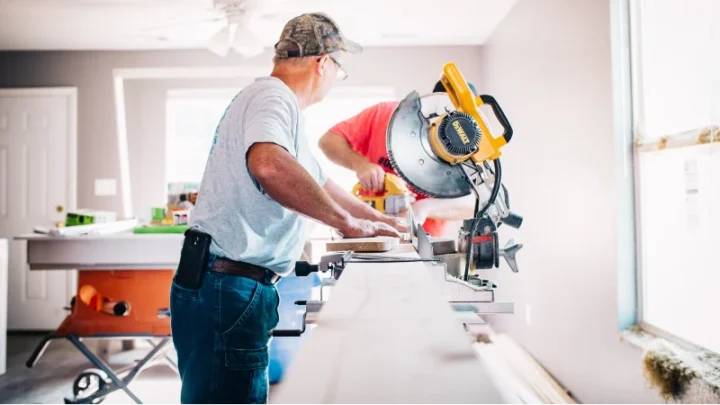Disclosure: This post may contain affiliate links, meaning we get a commission if you decide to make a purchase through our links, at no cost to you. Please read our disclosure for more info.
Renovating a home can be costly. Many homeowners have pure intentions when creating a renovation budget, then quickly find themselves surprised and overwhelmed. It’s one thing to set a budget and another to find viable solutions to stick to it.
Fortunately, there are many thrifty strategies for saving money during renovations. Here are six tips to save money on home upgrades and remodeling projects.
In This Post:
1. Know When to DIY and When to Hire Out
It’s a common misconception that taking a DIY route will save you money. While some tasks are perfect for an industrious homeowner with some basic skills, others are best left to the experts.
As a homeowner, feel free to DIY tasks like sanding, painting, and basic installations. However, it would be best to always leave things like electrical work, plumbing repair tasks and upgrades, and structural changes to the experts.
These specialized trades have licensing requirements for a reason. If something goes wrong with electrical work, it could cause a deadly electrical fire or shock. Water damage is similarly expensive and could end up costing you thousands. Making the wrong move structurally could put your entire home at risk. Worst of all, home insurance likely won’t cover these issues since they weren’t completed by a licensed professional.
In summary, DIY doesn’t always save you money.
2. Shop Discontinued Faucets and Fixtures
Upgrading faucets and fixtures can add up quickly. One cost-savvy way to save on these upgrades is to purchase discontinued options. Be a budget shopper and look for seasonal or year-end clearance sales, in which older stock is offloaded at a deep discount.
This remodeling approach is an effective way to modernize your home without breaking the bank. Keep an open mind when choosing colors and models for more pricing flexibility.
3. Focus on High-Value Adds
If you’re working with a tight budget, it’s beneficial to prioritize your upgrades by value. In other words, assessing how much value the upgrade will add to your home and quality of life.
For example, remodeling an outdated kitchen will help increase the resale value of your home while making it more enjoyable to live there in the meantime. Kitchen remodeling experts can help with showing you what needs to be changed to make it more appealing to new buyers. On the other hand, installing a luxury whirlpool tub might add perceived value to your home but might not appeal to potential buyers.
Whether you focus solely on resale value or personal value ultimately depends on your goals. If you’re remodeling to sell, take your personal preferences out of the equation.
4. Repurpose and Recycle Materials
Society has conditioned consumers to look at new purchases and materials as the only option during home remodeling projects. However, there are plenty of opportunities to repurpose and recycle materials.
Shop at the local Habitat for Humanity store and see if you can find discounted fixtures, hardware, and installations. Alternatively, upcycle your existing cabinetry and fixtures when possible. There are endless DIY options for refinishing light fixtures, handles, cabinets, floors, etc.
5. Prioritize Eco-Friendly Upgrades
Prioritizing eco-friendly upgrades just makes sense in the modern world. Many new homebuyers prioritize eco-friendliness and sustainability when looking for a house. Additionally, these upgrades tend to pay for themselves over time in utility savings.
During your remodeling project, prioritize upgrades like installing low-flow toilets and faucet aerators, tankless water heaters, new windows, and smart monitors to capitalize on these savings.
6. Extend Your Timeline
If you don’t have a set deadline for remodeling your home (i.e., a selling date), consider extending your timeline and working away at your upgrades. Maybe you will replace the fixtures this month and do a coat of paint next month. Perhaps the floors will get done this year, and the cupboards will get done next year.
The longer you take, the more you’ll be able to save and use cash rather than relying on credit and debt. This strategy is an effective way to save money for renovations of all sizes.
With these cost-saving strategies, you can make your house a home without breaking the bank.

